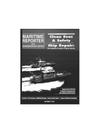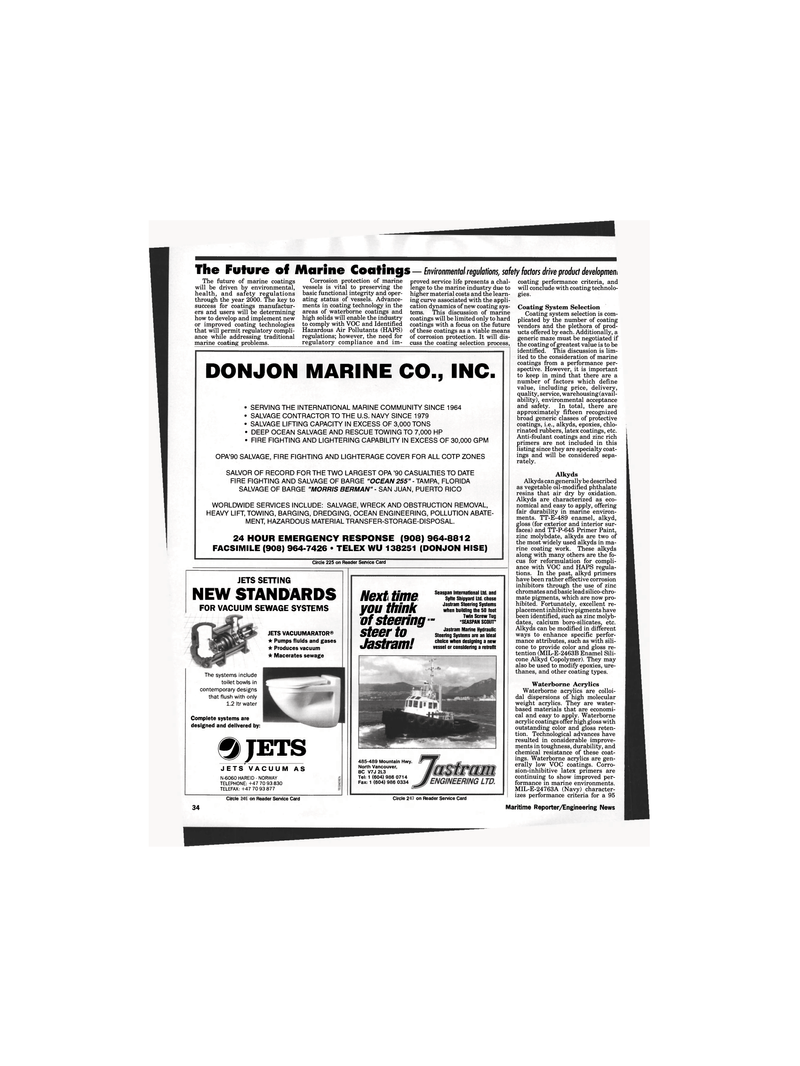
Page 32: of Maritime Reporter Magazine (October 1995)
Read this page in Pdf, Flash or Html5 edition of October 1995 Maritime Reporter Magazine
The Future of Marine Coatings — Environmental regulations, safety factors drive product development
The future of marine coatings will be driven by environmental, health, and safety regulations through the year 2000. The key to success for coatings manufactur- ers and users will be determining how to develop and implement new or improved coating technologies that will permit regulatory compli- ance while addressing traditional marine coating problems.
Corrosion protection of marine vessels is vital to preserving the basic functional integrity and oper- ating status of vessels. Advance- ments in coating technology in the areas of waterborne coatings and high solids will enable the industry to comply with VOC and Identified
Hazardous Air Pollutants (HAPS) regulations; however, the need for regulatory compliance and im- proved service life presents a chal- lenge to the marine industry due to higher material costs and the learn- ing curve associated with the appli- cation dynamics of new coating sys- tems. This discussion of marine coatings will be limited only to hard coatings with a focus on the future of these coatings as a viable means of corrosion protection. It will dis- cuss the coating selection process,
DONJON MARINE CO., INC. • SERVING THE INTERNATIONAL MARINE COMMUNITY SINCE 1964 • SALVAGE CONTRACTOR TO THE U.S. NAVY SINCE 1979 • SALVAGE LIFTING CAPACITY IN EXCESS OF 3,000 TONS • DEEP OCEAN SALVAGE AND RESCUE TOWING TO 7,000 HP • FIRE FIGHTING AND LIGHTERING CAPABILITY IN EXCESS OF 30,000 GPM
OPA'90 SALVAGE, FIRE FIGHTING AND LIGHTERAGE COVER FOR ALL COTP ZONES
SALVOR OF RECORD FOR THE TWO LARGEST OPA '90 CASUALTIES TO DATE
FIRE FIGHTING AND SALVAGE OF BARGE "OCEAN 255" - TAMPA, FLORIDA
SALVAGE OF BARGE "MORRIS BERMAN" - SAN JUAN, PUERTO RICO
WORLDWIDE SERVICES INCLUDE: SALVAGE, WRECK AND OBSTRUCTION REMOVAL,
HEAVY LIFT, TOWING, BARGING, DREDGING, OCEAN ENGINEERING, POLLUTION ABATE-
MENT, HAZARDOUS MATERIAL TRANSFER-STORAGE-DISPOSAL. 24 HOUR EMERGENCY RESPONSE (908) 964-8812
FACSIMILE (908) 964-7426 • TELEX WU 138251 (DONJON HISE)
Circle 225 on Reader Service Card
JETS SETTING
NEW STANDARDS
FOR VACUUM SEWAGE SYSTEMS
JETS VACUUMARATOR® * Pumps fluids and gases -k Produces vacuum -k Macerates sewage
The systems include toilet bowls in contemporary designs that flush with only 1.2 Itr water
Complete systems are designed and delivered by:
SJETS
J ETS VACUUM AS
N-6060 HAREID - NORWAY
TELEPHONE: +47 70 93 830
TELEFAX: +47 70 93 877
Next time you think of steering steer to
Jastram!
Seaspan International Ltd. and
Sylte Shipyard Ltd. chose
Jastram Steering Systems when building the 50 foot
Twin Screw Tug " "SEASPAN scoirr
Jastram Marine Hydraulic
Steering Systems are an Ideal choice when designing a new vessel or considering a retrofit 485-489 Mountain Hwy.
North Vancouver,
BC V7J 2L3
Tel: 1 (604) 986 0714
Fax: 1 (604) 986 0334
Circle 307 on Reader Service Card Circle 302 on Reader Service Card coating performance criteria, and will conclude with coating technolo- gies.
Coating System Selection
Coating system selection is com- plicated by the number of coating vendors and the plethora of prod- ucts offered by each. Additionally, a generic maze must be negotiated if the coating of greatest value is to be identified. This discussion is lim- ited to the consideration of marine coatings from a performance per- spective. However, it is important to keep in mind that there are a number of factors which define value, including price, delivery, quality, service, warehousing (avail- ability), environmental acceptance and safety. In total, there are approximately fifteen recognized broad generic classes of protective coatings, i.e., alkyds, epoxies, chlo- rinated rubbers, latex coatings, etc.
Anti-foulant coatings and zinc rich primers are not included in this listing since they are specialty coat- ings and will be considered sepa- rately.
Alkyds
Alkyds can generally be described as vegetable oil-modified phthalate resins that air dry by oxidation.
Alkyds are characterized as eco- nomical and easy to apply, offering fair durability in marine environ- ments. TT-E-489 enamel, alkyd, gloss (for exterior and interior sur- faces) and TT-P-645 Primer Paint, zinc molybdate, alkyds are two of the most widely used alkyds in ma- rine coating work. These alkyds along with many others are the fo- cus for reformulation for compli- ance with VOC and HAPS regula- tions. In the past, alkyd primers have been rather effective corrosion inhibitors through the use of zinc chromates and basic lead silico-chro- mate pigments, which are now pro- hibited. Fortunately, excellent re- placement inhibitive pigments have been identified, such as zinc molyb- dates, calcium boro-silicates, etc.
Alkyds can be modified in different ways to enhance specific perfor- mance attributes, such as with sili- cone to provide color and gloss re- tention (MIL-E-2463B Enamel Sili- cone Alkyd Copolymer). They may also be used to modify epoxies, ure- thanes, and other coating types.
Waterborne Acrylics
Waterborne acrylics are colloi- dal dispersions of high molecular weight acrylics. They are water- based materials that are economi- cal and easy to apply. Waterborne acrylic coatings offer high gloss with outstanding color and gloss reten- tion. Technological advances have resulted in considerable improve- ments in toughness, durability, and chemical resistance of these coat- ings. Waterborne acrylics are gen- erally low VOC coatings. Corro- sion-inhibitive latex primers are continuing to show improved per- formance in marine environments.
MIL-E-24763A (Navy) character- izes performance criteria for a 95 34 Maritime Reporter/Engineering News

 31
31

 33
33
